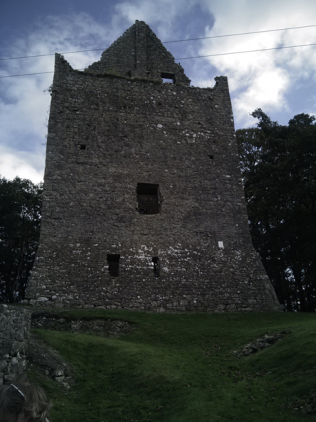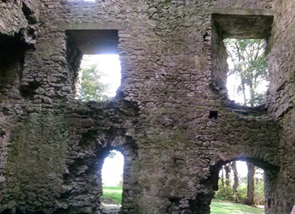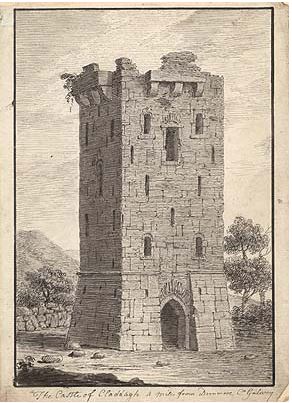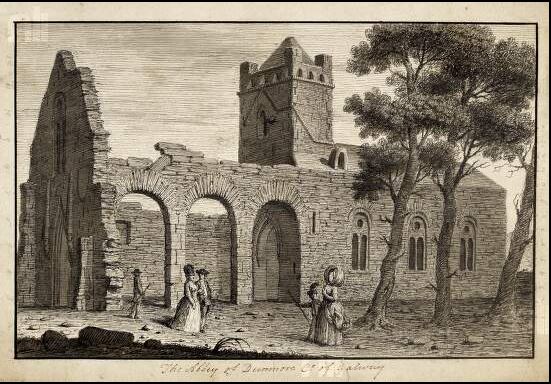Introduction
Dunmore is 15 kilometres north east of Tuam and it’s bounded on the north by County Roscommon, on the east by the parish of Clonbern and to the west is the parish of Addergoole.
Dunmore signifies a large Dun or earthen fort upon which Dunmore Castle was built on a sinking river. Tradition interprets it as an earthen fort erected by More, the daughter of the great navigator Manannan.
Haiste Mac Membric, a Welshe chieftain of the Anglo Norman Conquest built a castle here to the delight of Mor Ni Mananain, but the Berminghams came from the north and drove him out and remained there until the great wars of Ireland. (Neary, 1914).
Dunmore Castle stands on a small hill over a rivulet small stream, a short distance to the west of the town of Dunmore. I observed an intact lime kiln to the west side of the Castle, a later addition, possibly 19th century.

Dunmore Castle Image Mary O’Boyle
The Conquest of Connaught in 1235 by Richard de Burgh called for a whole series of castles to be built for family and tenants. They pushed out the O’Connors and the principal barons of Connaught under the de Burghs were the de Berminghams.(McNeill,1997).
The two major de Bermingham castles in Connaught were Athenry Castle and Dunmore Castle. The Augustinians arrived under the patronage of the de Berminghams and set up an Augustinan Friary in the town of Dunmore in 1425. Walter de Birmingham was a very generous benefactor of the friary and is buried within the friary grounds. (Bermingham, 2012)
Definition of a town in Medieval Ireland
Land and lordship was of central importance to the Anglo Normans. Towns played an essential role, primarily as market towns for produce of the castle and its people. They were also centres for imported commodities like wine, salt and silk.
Towns were homes of specialist craft workers and towns provided the lord of the manor with rents and in times of war, the loyalty of the town’s people could be relied upon. (Bradley, 1995).
The possession of a wall encompassing a town was the sign of a town that held its own urban status in high regard.
A battlement walkway, arrow loops and embrasures opening in a wall, at ground level protected walls. The majority of gatehouses were rectangular buildings. (Bradley, 1995).
Evidence of a walled town
Evidence exists to state that Dunmore was a walled town because it had a charter of Murage stating its importance. A murage was a tax and there were burgesses and collectors of this murage which was spent on burning lime and paying stonemasons (Knox, 1902).
A murage is a tax levied specifically for the building of a town wall or repair of one. There is a record of £2.55 been collected and spent on either construction or repair of the town wall. (Spelissy, 1999). In the 13th Century, the Anglo Normans constructed walled towns but none could compare with Dunmore and its charter of murage.(Knox,1902).
Additional defining evidence that Dunmore was a thriving medieval town was the system of stallage or renting of stalls which is indicative of trade, markets and fairs. These were key elements in both international trade and local economy (Knox, 1902).
In the borough of Dunmore and Galway in the 1270’s, murage was levied on things like wine, salt, wool and cloth (Knox, 1902).
For fifty years, Turlough O’Connor stood as the dominant figure of Ireland from 1106-1156 and he established a mint at Clonmacnoise. The Anglo Normans played a crucial role in the money economy of Connaught.
The 13th Century Anglo Norman Conquest of Connaught introduced coinage. Coins may not have been used in everyday transactions but coins were found in Dunmore during the Second World War but the finder of these coins is dead, nevertheless they were found in the Dunmore area (Kenny, 1991).
Town defences
A characteristic of Anglo Norman towns was the presence of defences inside a stone wall.(Bradley, 1999). Dunmore was a chartered town with powers to make by-laws, regulate townsfolk, and offer protection for businesses within its walls. (Neary 1914).
The Anglo Normans introduced ancient charters into Ireland and constructed walled towns but there was no town as important as Dunmore was because of its charter of murage. (Knox, 1912).
Another important characteristic in defining a medieval Anglo Norman town is the presence of a monastery or Friary. (Bradley, 1999). Walter de Bermingham built a fine friary at Dunmore in 1425 upon arrival of the Augustinans who were mendicant friars. Indulgences were offered to those who assisted and contributed towards the building of a friary.
Case study of Dunmore
Dunmore Castle
In 1133, Dunmore was plundered and Dunmore Castle demolished following an attack by Cormac McCarthy and Conor O’Brien of Thomond, killing Cathal O’Connor and his subchief, O’Flynn. In 1143 Morogh O’Melaghlin, King of Meath was imprisoned in Dunmore Castle by Turlough O’Conor, Ard Ri na hEireann but in 1156 after Turlough’s death Morogh was set free and he destroyed Connaught and burned Dunmore.(Neary, 1914).

View east side of Dunmore Castle
The Annals of the Four Masters say that in 1249, Dunmore was burned by the sons of the kings of Connaught. (Annals M1249.13). During the Norman Conquest of Connaught, under Richard de Burgh, the de Berminghams became principle barons of Connaught and built towns and castles in Dunmore and Athenry.
The first castle was erected in Dunmore in 1225 by the de Berminghams. They held it till Cronwellian times. Dunmore castle was a fortified structure. At the east end of Dunmore castle is the shattered remains of a double-towered gatehouse. (McNeill, 1999). Gatehouses permitted control over people entering and leaving the town and the primary function of a gatehouse was as a customs post. (Bradley, 1995).
Description of Dunmore Castle
Dunmore sits on a rock crop surrounded by a bog and a sinking river. It can be described as a two storey rectangular shaped building with an early 15h century first floor above.
There is a fireplace along the north wall window showing signs of seats. This building had a first floor hall and there is a hall in the rectangular enclosure. (McNeill, 1999).

Interior view of windows north side of Dunmore Castle
Dunmore castle could be described as a hall house, which is a distinctive type of small castle, or strong house. These hall houses were early fortified dwellings of lords, which seem to e a precursor of the numerous tower houses of Ireland. (Archaeology Ireland, Autumn, 1998).
There is a defensive ground floor with stilopes, timbered floor hall and more open windows. The difference between hall houses and hall keeps is that a hall keep is only one element of a large castle and a hall house seems to be an isolated structure. (Sweetman1999).

Arched doorway on south side of Dunmore Castle
Dunmore Castle was originally only two storeys high but has undergone extensive alterations. Vaults were inserted and extra accommodation provided where the latter additions mask the early hall house, which dates to 1225. The original building was certainly only two storeys high with the hall of the first floor level showing clear evidence of an external wooden stairs.

Lime kiln added in 19th C on west side of the Castle
It had a spiral staircase in the northeast angle for access to the ground floor and a garderobe toilet, in the north west angle of the hall. It had two further floor levels added in the late medieval period and a fireplace at each storey above ground level (Sweetman, 1999).
Rise and destruction of Dunmore Castle
The de Berminghams raised their massive quadrangular fortress on a huge mound beside a sinking river. The walls of the ramparts embankment, were built of rubble masonry, 20 foot high and 6 foot broad extending to the west in a circle of 800 yards. (O’Donovan, 1838).

Present day windows without framework
High up near the parapets low protective wall along the edge of a roof, two windows on the south side still intact show the kind of ornate sculptured stone framework which has disappeared from the others. The two gables of the roof rise on the inner sides of the east and west walls. (Neary,1914).
Ramparts barriers, bastions projecting parts, and oak works have gone but we still can imagine what a great fortress this castle once was. It was not time that destroyed this castle but vandals who not content with taking the cut stone ashlar, frame work from the five doors and ten windows, also removed the inscribed mural slab from the centre of the south wall. This slab would have thrown more light on the history of the castle.(Neary, 1914).
Claddagh Castle
Claddagh Castle is a 13th century hallhouse outside Dunmore. It now lies in ruins but in 1779 Angelo Maria Bigari, an artist was on tour in Connaught and made a sketch of the exterior view of the hall house at Claddagh showing a ground floor entrance recessed between battered walls on either side and windows of four floors above with machicolations, opening between supporting corbels, on the battlement level. (Grose’s Antiquities of Ireland, Vol 1 (1791).

Bigari, A. M. (291779). The Castle of Claddagh, 4 miles from Dunmore, Co Galway. Courtesy of the National Library of Ireland Ref: Coo 2122 TX (3) 21
In medieval fortification, a machicolation is an opening between the supporting corbels of a projecting parapet or the vault of a gate through which stones or burning objects could be dropped on attackers.
Claddagh Castle today lies in ruins, a pile of rubble as depicted on the above image on the right but was an imposing fortress in its day.
Dunmore Augustinian Friary
The Augustinians arrived in Dunmore under the patronage of Walter De Bermingham in the year 1425.(Bermingham, 2012). The date of foundation is given as 1425 but this is a misinterpretation because they actually arrived in 1423. Dunmore was mentioned in the register of the priors in 1425 but according to Monsignor D’alton of Tuam who published the History of Tuam in 1928, Dunmore Priory was founded in 1423. (Martin, 1956).

Dunmore Augustinian Priory
The de Berminghams, barons of Athenry were for more than six centuries considered one of the most ancient Anglo Norman families in Ireland. Walter de Bermingham was appointed sheriff of Connaught. (Galway historical Society, 2015).
Walter de Bermingham was the ninth baron of Athenry (1370-1428), a great warrior who has a plaque dedicated to his memory erected above the doorway of Dunmore friary. The O’Kellys were also generous benefactors. Thomas Ruadh O’Kelly was a very wealthy celebrated man who built a fine tomb for himself and his family in the friary grounds. (O’Donovan, Tribes and Customs, 1843).
The founding of such monasteries by the Irish and Anglo Normans were seen as a spiritual insurance for the benefactors and their families. The monks and local people prayed for the benefactor and in old age, the benefactor could retire to the monastery or take the habit. (Bermingham, 2012).
The Dunmore priory had particular importance in the history of the Irish Augustinians. At this time, there was religious suppression of the religious houses by Henry Vlll. Lord Birmingham interceded for Dunmore Priory stating that it was founded by his ancestors and that it was a very poor monastery among the Irish without profit or land. He said the suppression would be of no profit to Henry Vlll. (Martin, 1956)
The Lord Deputy and Council granted the request in 1542 and the priory was saved. Dunmore became the centre of Augustinian life for two centuries of persecution. (Martin, 1956).
Description of the Priory
The friary buildings had disappeared in penal times but it was still a priory and later it was occupied by a market place with the main part of the church still standing. The chancel was converted into a local protestant church. (Martin, 1956).

15th Cy doorway Dunmore Priory
Upon its foundation in 1423, the building consisted of a nave, crossing tower and chancel. The west gable has a fine 15th century doorway with carved heads on each side. There is a rectangular built-in stoup holy water basin, that occurs in the embrasure of this door. (Bermingham, 2012).

Medieval sculpture Dunmore Friary irisharchaeology.tumblr.com/
The tower, which is 15th-16th century, was lowered considerably in the 18th century, probably for safety reasons as the belfry deteriorated.
Originally the friary would have had a kitchen, church, tower house, refectory, chapter house, toilets, dormitories for monks and lay brothers, guest rooms for travellers and stables and barns for animals and food.(Bermingham, 2012).
Monk’s Expectations
The monks cared for the sick and their spiritual needs. They were skilled practitioners in medicine and treatment of fevers. They taught music and art to the nobility and patrons of the friary. The friary was an open house for travellers and pilgrims. It supplied the poor with food and its barns were used as graneries for people’s corn. (Bermingham, 2012).
The monastery in Dunmore was a source of life, a hospital, school, hotel and farm. It promoted sport, music and entertainment for the people.(Bermingham,2012).
Augustinian Dress Code
The Augustinian Friars wore a white tunic with a hood, inside the friary but in public, they wore a black habit over a white habit and hood, tied with leather cincture or belt.
The dress of the novice was similar except they wore a scapular over the shoulder. The friars received endowments of property and money.(Bermingham, 2012).
Italian artist and draughtsman Angelo Bigari while on tour of Connaught did the above sketch. This drawing depicts a view from the south of the Augustinian friary. The western side of the friary is roofless while the eastern side has been roofed. (Grose, 1792).
The chancel was converted into the local protestant church in the 18th Century. In 1641, it was still a fully functional monastery with a prior and thirty friars, and they did not fear going out in public in their habits (Martin, 1956).

Bigari, A. M. (281779). The Abbey of Dunmore Co. of Galway. Courtesy of the National Library of Ireland Ref: Coo 2122 TX (3) 20
Today the friary is roofless and closed up in the centre of Dunmore town. There now is a children’s playground on the east side and a supermarket on the southern side of the friary. The 15th Century doorway is very striking with its two sculptured heads on either side.
Religious Turmoil in the Medieval Catholic Church
Dunmore is in the Archdiocese of Tuam and during 1378-1417, there was great religious turmoil within the Catholic Church and the affects were felt in Tuam. This religious turmoil is often referred to as the Great Schism or the Papal Schism. This is where two popes and later three popes wanted supremacy within the Catholic Church. (Bermingham, 2012).
The cardinals of Rome elected Urban Vl, but he had a bad temper so the cardinals removed themselves from Rome and elected Pope Clement Vll of Avignon. A third Pope was elected called Pope Benedict Xlll. This caused great anxiety as to which pope was in authority among the people (medieval cronicles.com)
England sided with the pope and England’s enemies sided with the Avignon pope. The Avignon pope appointed Gregory O’Mochan to the Sea of Tuam. The Archdiocese of Tuam followed Avignon for 10 years.(Bermingham, 2012)
The Great Schism ended with the election of Pope Martin V in 1414. The Great Schism was a dispute within the church that turned into a diplomatic issue that affected all of Europe.(Medieval Cronicles.com.)
In the Archdiocese of Tuam, where Dunmore is a parish, the split within the catholic church lasted longer than elsewhere dating from 1383-1393 because rival archbishops supported by one pope or the other coexisted. The Roman candidate held the diocesan property but the Avignon candidate enjoyed local support and connections to hang on and thrive to the end.(Daileader, 2009).
When local chapter elected the Bishop of Clonfert, a supporter of Avignon as Bishop of Tuam, the Urbanist bishop of Tuam gave up his position and took up the position of Bishop of Clonfert and pledged allegiance to the Avignon pope. (Daileader, 2009).
In 1490, the pope was informed by Thomas Ogillaraga, a priest of the diocese of Tuam that William Russell, Vicar of Dunmore, a public simoniac publically committed purgury and dilapidated many of the goods of the vicarage. The letter was sent to the abbot of the Holy Trinity Tuam and to Thomas Obrayn and Nimeas Oruary, Canons of Tuam. If these three men found William Russell had truly done this deed, he would be deprived and removed and the vicarage would be assigned to the patronage of layman Thomas Ogillaraga to the value of 8 marks stirling. (Cal-papal-rolls 751:1490).
Conclusion
Turlough O’Connor became Ard Ri na hEireann after he strengthened his garrisons at Dunmore as well as Athlone, Dunamon and Ballinasloe. He built bridges across the Shannon and built ships for his many battles.
In 1235 Richard de Burgh following the Norman Conquest of Connaught pushes out the O’Connors. The principal barons of Connaught under the de Burghs were the de Berminhams and they built the first castle in Dunmore in 1235. Then in 1423 Walter de Bermingham founded the Augustinian friary in the town of Dunmore upon arrival of the Augustinian mendicant friars.
Walter de Bermingham and Thomas O’Kelly were generous benefactors of the friary. Walter died in 1428 and a plaque to his memory was erected above the fine 15th century doorway of Dunmore Friary.
Lord and lordship meant everything to the Anglo Normans. The medieval town of Dunmore is testament to this statement. Dunmore Castle was attacked many times throughout its history. Through rise and destruction, it still stands as a lasting structure with a turbulent past.
Time did not destroy Dunmore castle or rob it, but vandals stole its ashlar stone and inscribed mural slab that would have told us so much more about its fascinating history.
Bibliography
Primary Sources
‘Vatican Register 751: 1490-1491’ in Calendar of Papal Registers relating to Great Britain and Ireland: Volume 14 1484-1402, ed. JA Twemlow (London, 1960) pp.266-269. British history on line http// www.british-history.ac.uk/Cal-papal-registers/brit.ie/vol 14/pp 266-269 (accessed 12 November 2017).
http//www.celts.ucc.ie – annals of the four masters-(M1249-13)1249 (accessed 11 November 2017)
http//www.JSTOR.ORG-Journal of the Royal Society of Antiquaries of Ireland, Vol 67, 2015.
http//www.JSTOR.org-Sweetman, D., The Hall House in Ireland, Archaeology Ireland, Vol 12 No3 1998 13-16 (accessed 4 November 2017).
Neary, Rev. J., (1914), History and Antiquities of the Parish of Dunmore, internet archive-http://www.archive.org/details/on the history and antiquities of the parish of Dunmore by Rev, J. Neary.
Martin, F. X., O.S.A., (1956), The Augustinian Friaries in Pre-Reformation Ireland, internet archive- http://www.ucd.ie-martin-fx, (accessed 12 November 2017).
O’Donovan, J., to Geo A Larcom, (1838), Ordnance Survey Letters of the Parish of Dunmore. And Tribes and Customs, 1843.
Medieval Map of Dunmore taken from Dunmore, A History by Bermingham, H.
Secondary Sources
Knox, H, T., (1902), The Bermingham family of Athenry, Journal of Galway Archaeological and Historical Society,and the occupation of Connaught after 1237, Vol X 139-150. (1908) Internet archives, (accessed 28 October 2017).
Mc Neill, T., (1998), Castles in Ireland, Feudal Power in a Gaelic World, Macmillan Press Ltd.
Bermingham, H., (2012), Dunmore, A History. Dundalgan Press, Dundalk.
Bradley, J., (1995), Walled towns of Ireland, Towerhouse, Trinity College.
Spellissy, S., (1999), The History of Galway, City and County, Celtic Bookshop,Limerick.
Kenny, M., (1991), Journal of the Galway Archaeological and historical Society, Vol 43, 167-170, A small 15th century coin hoard from Dunmore, (available online via JSTOR)
Grose, F., (1791), Antiquities of Ireland, Vol 1 (available online http://www.libraryireland.com).
Joelle, R., Koster, and Izbicki, T, M.,(ed) (2009), A Companion to the Great Western Schism (1378-1417), Daileader, P., Chapter 89, Local Experiences of the Great Western Schism (available online http://brill.com-references).
Http://medievalchronicles.com-the great western schism
Images
http://pintergest image 640×638
http://www.angelomariabigari, 1779, Claddagh Castle and Dunmore Augustinian Friary.
Photos of Dunmore, by Mary O’Boyle







No Comments
Add a comment about this page